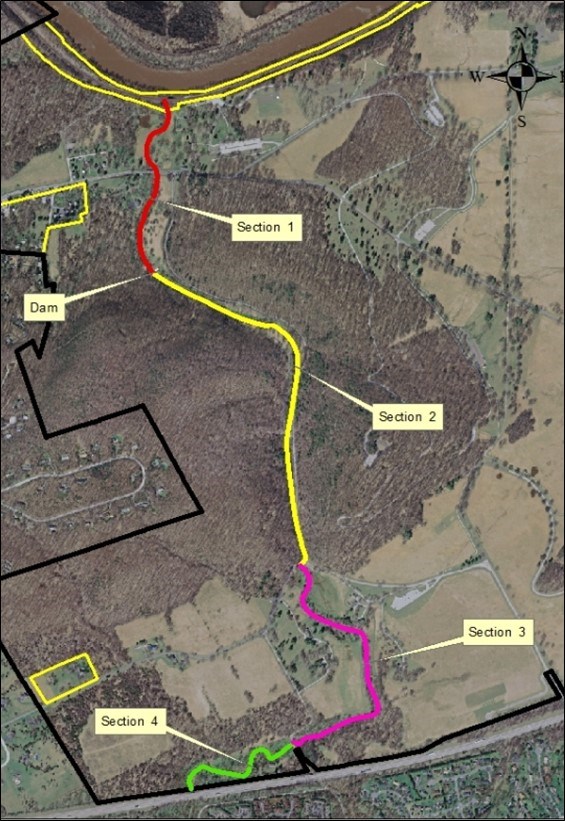Last updated: April 13, 2023
Article
Crayfish Corps Resource Brief 2021

NPS Photo/G. Purifoy
Crayfish Corps is a management action led by Natural Resource staff and supported by volunteers, which aims to limit the effects of invasive non-native crayfish in Valley Creek. Valley Creek is an Exceptional Value Waterway and Class A wild trout fishery.

NPS Photo
2009 - 2021 Status & Trends
In 2008, the invasive rusty crayfish (Faxonius rusticus) (Figure 1) was first documented in Valley Creek. In response, staff established the volunteer Crayfish Corps to suppress the invasion of rusty crayfish.
The rusty crayfish is native to parts of Ohio, Indiana, and Kentucky. It is larger and more aggressive than the park’s native crayfish, enabling the rusty crayfish to out-compete natives for food and shelter. The rusty crayfish also has the potential to disrupt the trout fishery in Valley Creek by eating trout eggs as well as most of the prey items for the fish. Wherever the rusty crayfish has been introduced with no subsequent management action, all other crayfish have been greatly reduced or eliminated.

NPS Image
Valley Creek is divided into four sections (Figure 2). These sections are defined by physical barriers (dams and bridges) as well as varying stream conditions.
From May through September, volunteers from AmeriCorps, scout troops, families, schools, community organizations, corporate groups, and individuals assist park staff to capture and remove rusty crayfish.
Over the past eleven years, volunteers have removed a total of 27,505 rusty crayfish from the creek. Another 72,065 native crayfish have been documented and returned (Figure 3).
Prior to 2020, the Crayfish Corps had over 300 volunteers and 1000+ volunteer hours annually. In 2020, all crayfish removal was done by park staff due to the pandemic. In 2021, the park continued to restrict group sizes for the Crayfish Corps but was able to support 71 volunteers that contributed 220 hours toward rusty removal. Most years, the majority of volunteers and volunteer hours were youth under the age of 18.
Complete eradication of the rusty crayfish is not feasible. The goal is to maintain a ratio of not more than 4:1 of native to rusty crayfish (e.g., 20% or less rusty crayfish), in Valley Creek upstream from the dam along Route 252 (Figure 2).

NPS Graphic

NPS Graphic
Since group size, duration, and stream conditions are variable, the crayfish data are standardized as number of crayfish caught per person-hour spent in the stream. This standardization allows park biologists to better evaluate which sections need more work and whether the park is reaching its goals (Figure 5). Rusty crayfish catch totals and catches per person hour were higher in 2021 than those of the two preceding years (Figures 3 and 5), but overall, since 2009, the trend is downward.
The percentage of rusty crayfish captured is consistently greater in Section 1 compared with Sections 2 through 4 (Figure 4). The dam separating Section 1 and Section 2 probably slows upstream movement from the Schuylkill River. Apart from Section 1 located below the dam, the rusty crayfish population has been maintained nearly at or below the 20% threshold goal in recent years.

NPS Graphic
Conclusions
In 2021, the percent rusty crayfish increased slightly above 20% in Section 2, indicating a need to focus on that section in 2022.
The overall trend of decreasing catches per-person hour over time and maintenance of less than 20% rusty crayfish above the dam is encouraging as evidence of the effectiveness of the program.
The continual success of Crayfish Corps is entirely due to the hard work and enthusiasm of all the volunteers involved in the program. Thank You!
Get Involved
You can contact Natural Resource Management staff to join the Crayfish Corps and find more information about signing up to volunteer at the link below.
Learn how to sign up and see upcoming Crayfish Corps dates
Natural Resource Management Staff
Kate Jensen
Ecologist
kate_jensen@nps.gov
Ashley Kroon
Biological Sciences Technician
ashley_kroon@nps.gov
This report prepared by:
Liam Gorman
2021-22 Natural Resource Management Intern
